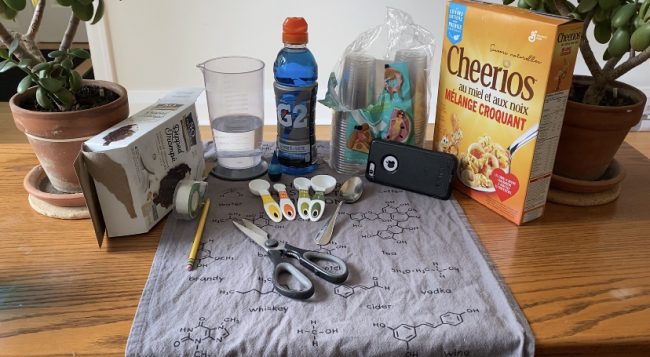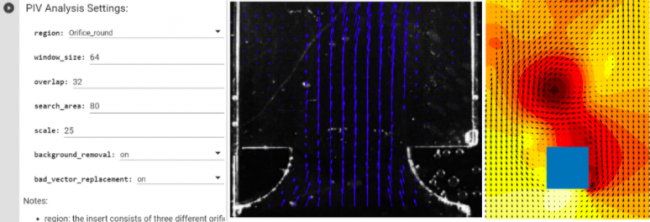
By Liz Do
A camera and a bottle of Gatorade were the key pieces of equipment for a recent virtual lab in Professor Jennifer Farmer’s (ChemE) course, CHE204: Applied Chemistry.
“We told students that they’d have to determine the amount of food dye in the drink,” explains Farmer.
Any other year, students would learn to operate a spectrometer to find the answer.
“Well, we don’t have spectrometers at home — or do we?”
During the COVID-19 pandemic, instructors and teaching assistants (TAs) across U of T Engineering have had to get creative in finding new, engaging and equitable ways to conduct labs — a traditionally hands-on and collaborative in-person learning experience — without on-campus equipment, software or space.
Farmer is using a combination of “kitchen labs,” simulated lab platforms and data analysis reports to create a new lab experience. And in the case of this recent assignment: students used a camera or smartphone in place of a spectrometer.
“It was important that the labs were accessible and that students could use what they have on hand at home instead of procuring specialty items and tools,” says Farmer.
Another important goal of Farmer’s is to ensure her students still get to build relationships with their peers. For the kitchen labs, she puts students into teams to mimic the interactions of a lab setting.
“Normally, students will be looking over and going, ‘Oh, it didn’t work for you either? Ok, so is it the chemistry that’s not working?’ and they talk it out to solve it,” she says. “I want to provide that same conversation from their own homes.”
In AER 210: Vector Calculus and Fluid Mechanics, second-year Engineering Science students in Professor Alis Ekmekci’s (UTIAS) course would typically learn fundamental fluid mechanics concepts by participating in a flow visualization lab.
This activity involves using Particle Image Velocimetry (PIV), an optical flow measurement technique, to analyze data, sketch flow lines and do calculations. In the past, the team used software that runs concurrently with the flow visualization lab equipment on physical computers within the laboratory.
When faced with the challenge of pivoting the lab online, Ekmekci and her TA, Pouya Mohtat (UTIAS PhD candidate), were determined to find a solution to deliver a similar experience remotely.

“We could have just given the students readily analyzed experimental data and asked them to put together a lab report on it, but that would not be very interactive — they need to experience handling data and extracting results,” says Ekmekci.
Mohtat spent the summer developing an interactive and user-friendly tool to help students with the lab exercises on flow visualization. The tool runs on virtual machines in the cloud, making it accessible for students wherever they are.
“What we have built enables students to do interactive exercises on their own time. They can analyze PIV data sets by themselves, run computational flow simulations, and compare experimental and computational results using the user-friendly interactive tools that we have developed for them,” says Mohtat.
Ekmekci hopes that their approach and solution will help other faculty members looking for accessible and interactive exercises for their students.
Professor Chris Bouwmeester (BME) is looking ahead to the Winter term and how he’ll foster engagement among graduate students in BME 1802: Applying Human Factors to the Design of Medical Devices.
“I’m playing around with a couple of ideas,” says Bouwmeester. Normally for each lecture, Bouwmeester would bring in different medical devices for students to study and pass around the class.
“My goal was to always put these instruments in students’ hands so they can understand how they work, and how confusing or straightforward these devices can be,” explains Bouwmeester. “To recreate that experience virtually is a tough challenge.”
Inspired by his daughter’s love of the stop-motion animated show Tiny Chef, “I thought, maybe I could do these little stop-motion videos of the instruments I have on hand at home.”

The stop-motion aspect of filming the devices means students can rotate them, go backward and forward, in order to better understand them.
“I could have just filmed them, that would be much easier,” says Bouwmeester. “But if students wanted to pause at a part, the device might look blurry. I wanted to give each movement purpose.”
Another activity in the course enables students to experience administering Naloxone, a medication used to quickly counteract the effects of opioids. Using a simulated version of the Naloxone kit, students would time themselves as they open the kits, read the instructions, open the practice vials and inject the drug into an orange.
“The course is about how to redesign devices to be safer and easier to use, so it’s important for students to get to experience the equipment and to experience the errors that are easy to make,” he says.
Though still in the brainstorming phase, Bouwmeester hopes to translate this experience remotely by mailing out the simulated kits to students, having them film themselves administering it and getting other students to watch and observe any errors.
“I’ve had to think harder this year, because my philosophy is to have students get that hands-on experience — that was my whole reason for teaching in the Myhal Centre,” says Bouwmeester. “Labs and design classes are all about applying your knowledge, iterating and learning from your mistakes. And that should still be true online.”
More cool labs
Other U of T Engineering professors who are thinking creatively to deliver their lectures and labs include:
- Professor Emeritus Joseph C. Paradi (ChemE, MIE) and Lecture Fellow Margarete Von Vaight, a trained opera singer, engineering consultant and Faculty of Music alumna, are leveraging music and creativity to deliver Entrepreneurship & Small Business. This includes the voluntary Dollar Store Challenge, where students are assigned a fictional case and are tasked to create a musical instrument, costing under $10, for an individual suffering from a physical or mental health issue.
- ECE students can conduct many of their labs at home, thanks to “CPUlator,” a free CPU simulator designed and maintained by alumnus Henry Wong (CompE 0T6, ECE PhD 1T7). The computer program effectively and efficiently simulates hardware that they would use when learning the fundamentals of how computers work. Wong’s simulator has been used 280,000 times — both by U of T Engineering students and students at other institutions.
- Professor Grant Allen, Chair of ChemE, has produced a video series that uses a leaf blower as an example of a fluid mechanics device that uses a ‘pump’ and transfers momentum. The videos, which have received overwhelmingly positive reactions from students, were produced near his family cottage and feature ample cameos from his dog, Layla.
This story was originally published in the U of T Engineering News.